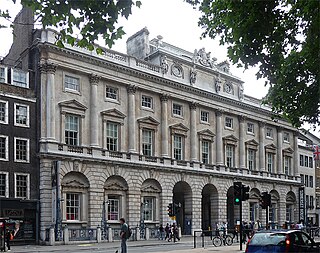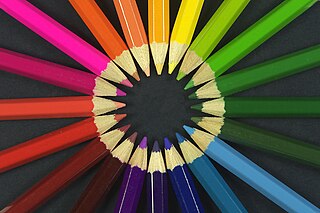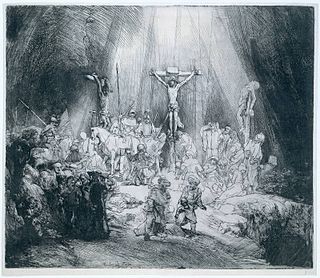Related Research Articles
The Library of Congress Classification (LCC) is a system of library classification developed by the Library of Congress in the United States, which can be used for shelving books in a library. LCC is mainly used by large research and academic libraries, while most public libraries and small academic libraries used the Dewey Decimal Classification system. The classification was developed by James Hanson, with assistance from Charles Martel, in 1897, while they were working at the Library of Congress. It was designed specifically for the purposes and collection of the Library of Congress to replace the fixed location system developed by Thomas Jefferson.

The Universal Decimal Classification (UDC) is a bibliographic and library classification representing the systematic arrangement of all branches of human knowledge organized as a coherent system in which knowledge fields are related and inter-linked. The UDC is an analytico-synthetic and faceted classification system featuring detailed vocabulary and syntax that enables powerful content indexing and information retrieval in large collections. Since 1991, the UDC has been owned and managed by the UDC Consortium, a non-profit international association of publishers with headquarters in The Hague, Netherlands.

Printmaking is the process of creating artworks by printing, normally on paper, but also on fabric, wood, metal, and other surfaces. "Traditional printmaking" normally covers only the process of creating prints using a hand processed technique, rather than a photographic reproduction of a visual artwork which would be printed using an electronic machine ; however, there is some cross-over between traditional and digital printmaking, including risograph.

The Courtauld Institute of Art, commonly referred to as The Courtauld, is a self-governing college of the University of London specialising in the study of the history of art and conservation. It is among the most prestigious specialist colleges for the study of the history of art in the world and is known for the disproportionate number of directors of major museums drawn from its small body of alumni.

The German Renaissance, part of the Northern Renaissance, was a cultural and artistic movement that spread among German thinkers in the 15th and 16th centuries, which developed from the Italian Renaissance. Many areas of the arts and sciences were influenced, notably by the spread of Renaissance humanism to the various German states and principalities. There were many advances made in the fields of architecture, the arts, and the sciences. Germany produced two developments that were to dominate the 16th century all over Europe: printing and the Protestant Reformation.

Line engraving is a term for engraved images printed on paper to be used as prints or illustrations. The term is mainly used in connection with 18th- or 19th-century commercial illustrations for magazines and books or reproductions of paintings. It is not a technical term in printmaking, and can cover a variety of techniques, giving similar results.
Isidoro Ocampo was a Mexican artist during the Mexican Muralism era, best known for his graphic work. Much of his career was dedicated to teaching, which kept his artistic output low, but he was also a founding member of the Taller de Gráfica Popular and the Sociedad Mexicana de Grabadores as well as member of the Liga de Escritores y Artistas Revolucionarios and the Salón de la Plástica Mexicana.

The following outline is provided as an overview of and topical guide to the visual arts:

An old master print is a work of art produced by a printing process within the Western tradition. The term remains current in the art trade, and there is no easy alternative in English to distinguish the works of "fine art" produced in printmaking from the vast range of decorative, utilitarian and popular prints that grew rapidly alongside the artistic print from the 15th century onwards. Fifteenth-century prints are sufficiently rare that they are classed as old master prints even if they are of crude or merely workmanlike artistic quality. A date of about 1830 is usually taken as marking the end of the period whose prints are covered by this term.

A print room is a room in an art gallery or museum where a collection of old master and modern prints, usually together with drawings, watercolours, and photographs, are held and viewed.
The Harvard–Yenching Classification System is a library classification system for Chinese language materials in the United States of America. It was devised by Alfred Kaiming Chiu (1898–1977). The system was primarily created for the classification of Chinese language materials in the Harvard–Yenching Library which was founded in 1927 at the Harvard–Yenching Institute.

The Master of the Playing Cards was the first major master in the history of printmaking. He was a German engraver, and probably also a painter, active in southwestern Germany – probably in Alsace, from the 1430s to the 1450s, who has been called "the first personality in the history of engraving."

Krishna Reddy was an Indian master printmaker, sculptor, and teacher. He was considered a master intaglio printer and known for viscosity printing.

The Museum of Byzantine Culture is a museum in Thessaloniki, Central Macedonia, Greece, which opened in 1994.

The Central Academy of Fine Arts is the only institution of higher education for fine arts under the direct charge of the Ministry of Education of China. The Manila Bulletin calls the school "China’s most prestigious and renowned art academy." It is one of the most selective universities in the country and turns away more than 95% of applicants every year. The acceptance rate was only 1.58% in 2019. Central Academy of Fine Arts is included in the Chinese state Double First-Class Construction as a Double First Class University. Central Academy of Fine Arts was the first national school of fine arts in Chinese history, and also the beginning of Chinese modern education of fine arts. Since its establishment in 1918, it has produced many notable Artists.
Rosa Tavarez was a Dominican painter and engraver.

The visual arts are art forms such as painting, drawing, printmaking, sculpture, ceramics, photography, video, filmmaking, comics, design, crafts, and architecture. Many artistic disciplines, such as performing arts, conceptual art, and textile arts, also involve aspects of the visual arts as well as arts of other types. Also included within the visual arts are the applied arts, such as industrial design, graphic design, fashion design, interior design, and decorative art.
The first School of Fine Arts was established in 1908 in Cairo. Established college in Alexandria in 1957. And its founder, the late Prof. Dr. / Ahmed Osman. One of the pioneers of contemporary sculpture and its first dean. The study aims at the college to prepare and graduate cadres specialized in the fields of Fine Creation through disciplines Departments five :.
Andrew Stein Raftery is an American artist and educator, known for his paintings, burin engravings, and drawings on fictional and autobiographical narratives of contemporary American life.
References
- ↑ "Library of Congress Classification Outline:Class N - Fine Arts" (PDF). Library of Congress. 2019-04-30. Retrieved 2019-04-30.
- ↑ "Library of Congress Classification Full Text: CLASS N - Visual Arts" (PDF). Library of Congress. 2019-05-01. Retrieved 2019-05-01.